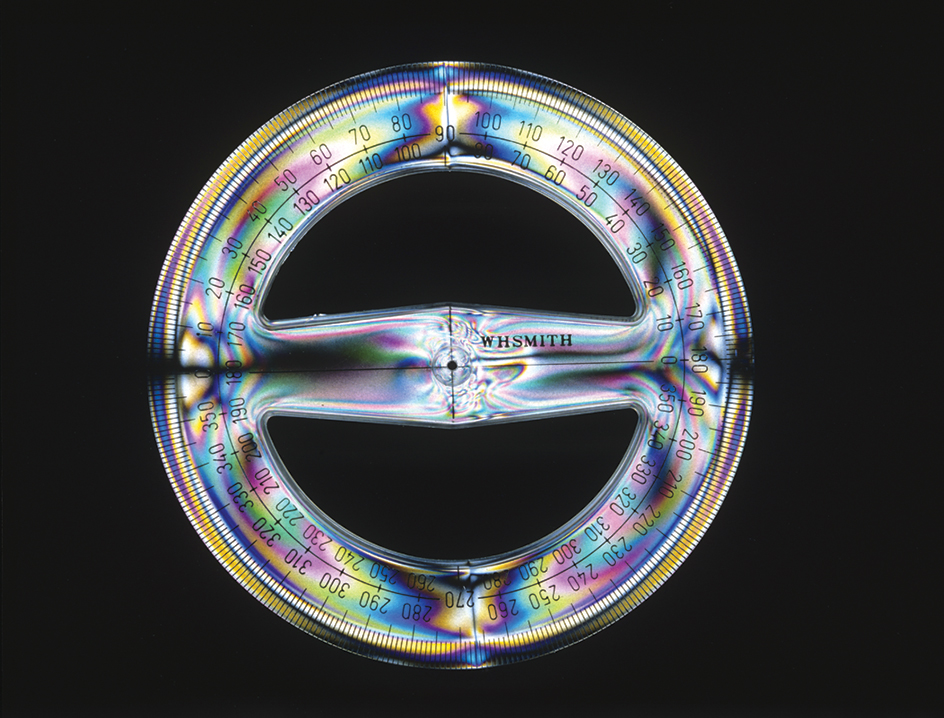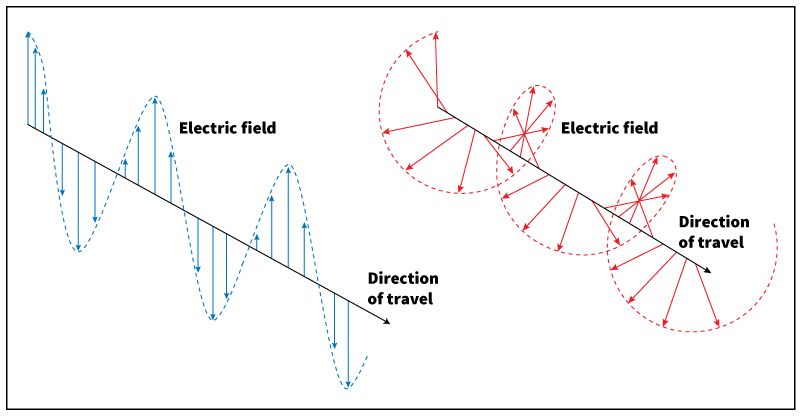Polarized light consists of light waves that vibrate in simple, regular patterns. In most of the light that we see, such as light from the sun or a lamp, the waves vibrate in many different directions. Such light is said to be unpolarized. If the vibrations stay in the same direction or form the same shape for a long time, the light is said to be polarized. Special filters that polarize light aid in the study of light and serve as tools in many industries. Polarized light also finds use in consumer products.

Understanding polarized light.
To understand the behavior of a light wave, imagine a rope tied to something stationary at one end. If you shake the loose end of the rope, the rope oscillates (moves back and forth), causing a wave to travel along its length. If you shake the rope up and down, it will oscillate vertically. If you shake side to side, the rope will oscillate horizontally. The rope can oscillate in directions perpendicular (at right angles) to the direction in which the wave travels.
Light waves travel in much the same way as waves in the rope. But light waves are carried by electric fields and magnetic fields, electric and magnetic influences acting throughout regions of space (see Light (Electromagnetic waves)). Just like the rope, electric and magnetic fields can oscillate in directions perpendicular to the direction in which light waves travel.

The simplest type of polarized light is linearly polarized light, also called plane polarized light. In such light, the electric field oscillates in a single direction. The direction of this oscillation determines the direction of polarization. If the electric field oscillates only up and down, the light is said to be vertically polarized. In horizontally polarized light, the electric field only oscillates from side to side.
In some light waves, the direction of the electric field rotates in a circle, tracing out a spiral as the wave travels. Such light is said to be circularly polarized.
Polarizing filters,
or polarizers, can separate polarized light. For example, a horizontally polarized filter allows only horizontally polarized light to pass. The polarizer blocks all light polarized in other directions. A vertical polarizer lets through only vertically polarized light. The direction of polarization that is allowed to pass through a filter is known as the filter’s pass axis or transmission axis.
A polarizing filter can produce polarized light from unpolarized light. If a beam of unpolarized light is sent through a horizontal polarizer, for example, the light passing out of the filter will be horizontally polarized.

Imagine placing a second, vertical polarizer after a horizontal polarizer. Because the light coming from the horizontal filter is horizontally polarized, no light will pass through the vertical filter. However, if the second polarizer is rotated, the amount of light passing through will gradually increase. When the second filter’s pass axis becomes parallel to that of the first filter, all the light allowed through the first filter will also pass through the second filter.
Some polarizers are made of specially cut pieces of calcite, a natural crystal. When light enters such a crystal, it splits into two beams of different polarization. By joining two such crystals so that one beam is directed away, the crystals can be used as a linear polarizer. More common polarizers are made from plastic sheets that contain stretched polymers (long chain molecules). The sheets absorb light that is polarized parallel to the polymers but let through light polarized in a perpendicular direction.
Polarized light can also be produced when unpolarized light reflects off a nonmetallic surface. For example, sunlight is unpolarized, but if it hits the surface of a lake or a car windshield, some of the reflected light is polarized. The reflected light consists of more horizontally polarized light than does the light coming directly from the sun. For this reason, many people wear polarized sunglasses on bright, sunny days. The glasses have vertical polarizers, which screen out horizontally polarized glare from the surfaces of water, roads, and other cars.
Uses of polarized light.
Scientists and engineers use polarized light to study the internal structure of many transparent materials. If an object is placed between a horizontal and a vertical polarizer and light is shined on it, regions where the object is stressed or strained will appear in different colors. If a pair of glasses is placed between the filters, for example, colored areas of stress will be visible inside the glass. These areas indicate weak spots that develop during the manufacture of the glasses. Engineers can use this technique to study stress within many materials. Chemists use a similar method to identify certain substances.
Many everyday devices make use of polarized light. Photographers use circular polarizing filters to eliminate reflections and to enhance colors. Polarizers find use in liquid crystal display (LCD) screens for cell phones and flat-screen computer monitors and televisions. Each pixel (picture element) of an LCD contains a horizontal and a vertical polarizer. Applying a voltage to the pixel determines whether or not light can pass through both filters. As a result, the pixel can change from light to dark.
See also Land, Edwin Herbert; Light (Electromagnetic waves); Tourmaline.
